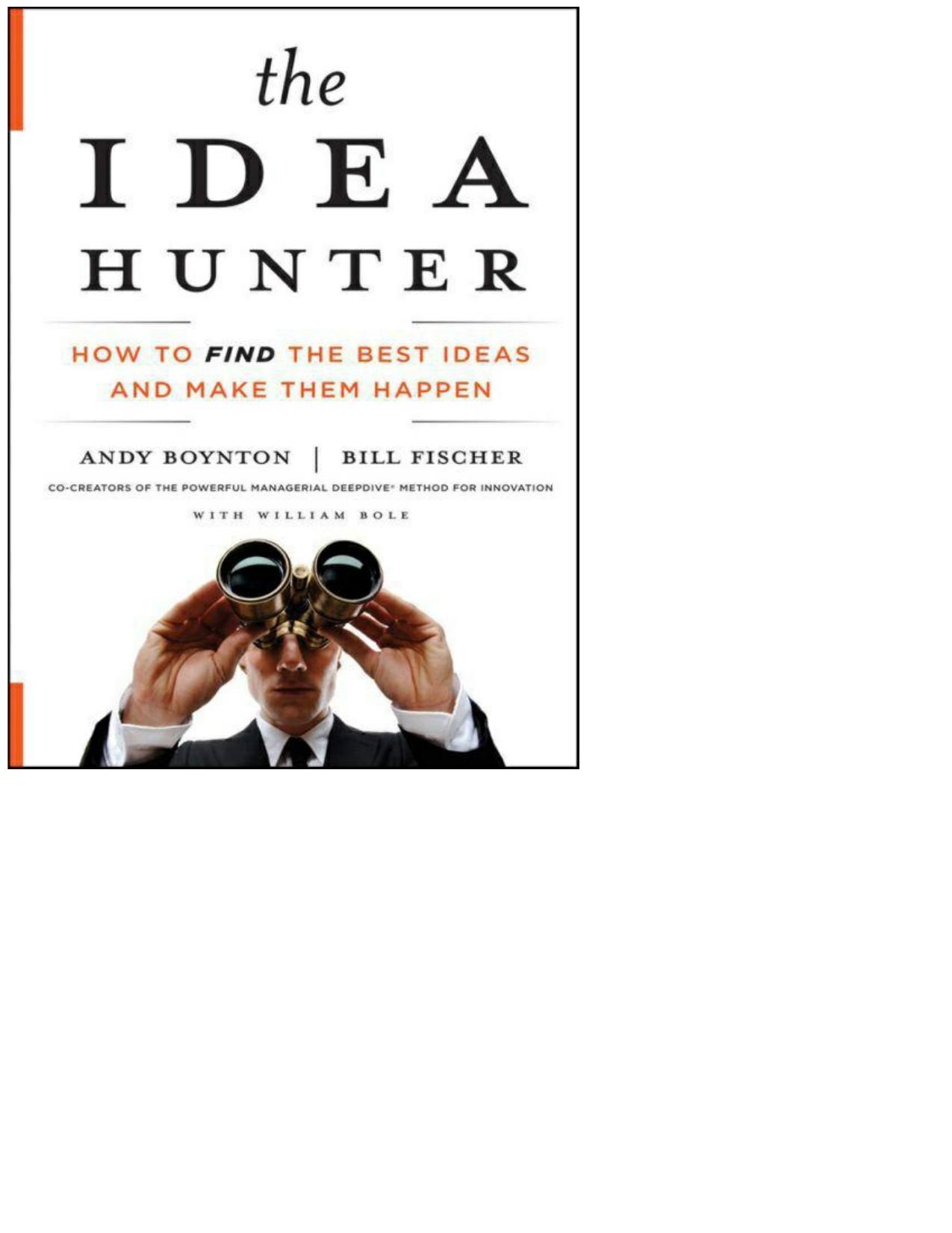The Idea Hunter by Fischer Bill & Boynton Andy & Bole William

Author:Fischer, Bill & Boynton, Andy & Bole, William
Language: eng
Format: epub, pdf
Write It Down
Ritz-Carlton employees, Credit Suisse executives, and Sam Walton al recorded their observations unfailingly. Writing down your thoughts and observations—and keeping them in a readily accessible place—are necessary habits of the Hunt. That’s partly because most of us do not have photographic memories, but also because ideas tend to arrive in bits and pieces that need to be put together over time. And it’s easy to forget a fragment that, standing alone, seems unimportant.
You can do more with your notes than just preserve your observations, however. You can begin editing those observations, weeding out the ones that truly seem unimportant and keeping those that are more relevant to your projects and goals. In fact, recording is one of the first tangible steps toward assembling ideas: Perhaps you’l connect something you heard at a PTA meeting to something you learned in a training program at work.
Furthermore, over time, your notes create another valuable resource: an archive of your old ideas and impressions.
Thomas Edison was a tireless note taker. He recorded his thoughts in more than 2,500 notebooks, most of which were at least 200 pages long.
“Through Edison’s use of notebooks,” writes his great-grandniece Sarah Mil er Caldicott, together with Michael J. Gelb, “the tangible world of experimentation met the intangible world of imagination.” Edison made notes freely, often with rough sketches of incipient ideas or just fragments related to an extensive array of technologies. He would capture his thoughts about products he was developing for the telegraph or railway industries and eventual y connect these and other observations to form the basic ideas for something new, like the phonograph. Edison wrote down everything he felt was worth jotting down, but he didn’t feel pressure to organize the fragments immediately or unite them into an idea right away. He let that process develop natural y over a period of days, months, years.
One day in 1888, the pioneering nature photographer Eadweard Muybridge went to see Edison, bringing along some of his photos depicting animals in motion. At the time, Edison was looking to improve the phonograph, and he made note of the fol owing intention: to experiment on an instrument that “does for the eye what the phonograph does for the ear.” Kathleen McAuliffe, writing about this in Atlantic Monthly in 1995, explained: “He went on to describe the paral el between the spiral of images that make up what we now cal film and the spiral grooves of the phonograph record.” A few years later, the first motion-picture camera evolved from these observations.
Keeping a daily notebook is not for everyone, but there are numerous alternatives for tracking your insights and observations. Some people tuck a sheet of notepaper, with their jottings, into a file folder related to an applicable project. Others attach a sticky note to the edge of a computer screen or onto a bul etin board. Stil others shoot e-mails to themselves (with clear subject headings) or store thoughts in a BlackBerry or keep a running log of ideas in a wordprocessing file.
Download
The Idea Hunter by Fischer Bill & Boynton Andy & Bole William.pdf
This site does not store any files on its server. We only index and link to content provided by other sites. Please contact the content providers to delete copyright contents if any and email us, we'll remove relevant links or contents immediately.
Bad Blood by John Carreyrou(5770)
Principles: Life and Work by Ray Dalio(5322)
Rich Dad Poor Dad by Robert T. Kiyosaki(5150)
Management Strategies for the Cloud Revolution: How Cloud Computing Is Transforming Business and Why You Can't Afford to Be Left Behind by Charles Babcock(4131)
The Confidence Code by Katty Kay(3566)
Thinking in Bets by Annie Duke(3533)
American Kingpin by Nick Bilton(2972)
Playing to Win_ How Strategy Really Works by A.G. Lafley & Roger L. Martin(2957)
Delivering Happiness by Tony Hsieh(2922)
Project Animal Farm: An Accidental Journey into the Secret World of Farming and the Truth About Our Food by Sonia Faruqi(2661)
Brotopia by Emily Chang(2592)
I Live in the Future & Here's How It Works by Nick Bilton(2525)
Mastering Bitcoin: Programming the Open Blockchain by Andreas M. Antonopoulos(2512)
The Content Trap by Bharat Anand(2493)
The Power of Habit by Charles Duhigg(2489)
The Marketing Plan Handbook: Develop Big-Picture Marketing Plans for Pennies on the Dollar by Robert W. Bly(2414)
The Tyranny of Metrics by Jerry Z. Muller(2401)
Building a StoryBrand by Donald Miller(2361)
Applied Empathy by Michael Ventura(2330)
